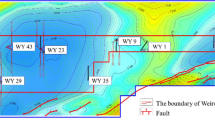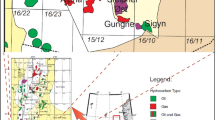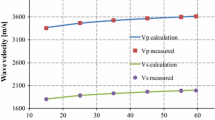Abstract
The knowledge of Biot’s effective stress coefficient is of particular importance to simulate the effects of pore pressure variations during reservoir depletion and injection operations. Direct experimental evaluation of this parameter can be limited by the availability of good quality cores. The experiments can also be expensive and time-consuming particularly in low-permeability formations. This paper presents a method to evaluate a 3D spatial model of Biot’s effective stress coefficient based on well logs and the empirical correlation between dynamic and static Young’s modulus in the wells. To estimate static Young’s modulus, uniaxial compression tests are performed on the cores obtained from Asmari reservoir in the Gachsaran oil field and the correlation between static and dynamic Young’s moduli is established. The mineral volume fraction in the wells is obtained from mineralogy log and validated using thin-sections, XRD, XRF, and SEM studies. Bulk and solid bulk modulus are estimated and a 1D model was built for 47 wells in the field, which is validated using two samples in one of the wells. An empirical relation has been obtained to estimate Biot’s effective stress from total porosity log. Then, a 3D spatial model of Biot’s effective stress coefficient has been presented by Sequential Gaussian Simulation (SGS) in the Gachsaran oil field, southwest of Iran.













Similar content being viewed by others
References
Alizadeh B, Maroufi K, Fajrak M (2017) Hydrocarbon reserves of Gachsaran oil field, SW Iran: geochemical characteristics and origin. Mar Pet Geol
Altmann JB, Müller BIR, Müller TM, Heidbach O, Tingay MRP, Weißhardt A (2014) Pore pressure stress coupling in 3D and consequences for reservoir stress states and fault reactivation. Geothermics 52:195–205. https://doi.org/10.1016/j.geothermics.2014.01.004
ASTM C830-00 (2016) Standard test methods for apparent porosity, liquid absorption, apparent specific gravity, and bulk density of refractory shapes by vacuum pressure. ASTM International, West Conshohocken, PA, 2016. www.astm.org
ASTM D2938-95 (2002) Standard test method for unconfined compressive strength of intact rock core specimens (withdrawn 2005). ASTM International, West Conshohocken, PA, 1995. www.astm.org
Belkhatir M, Schanz T, Arab A (2013) Effect of fines content and void ratio on the saturated hydraulic conductivity and undrained shear strength of sand--silt mixtures. Environ Earth Sci 70:2469–2479
Belmokhtar M, Delage P, Ghabezloo S, Tang AM, Menaceur H, Conil N (2017) Poroelasticity of the Callovo--Oxfordian claystone. Rock Mech Rock Eng 50:871–889
Biot MA (1941) General theory of three-dimensional consolidation. J Appl Phys 12:155–164
Bordenave ML, Hegre JA (2010) Current distribution of oil and gas fields in the Zagros Fold Belt of Iran and contiguous offshore as the result of the petroleum systems. Geol Soc Lond Spec Publ 330:291–353
Braun P, Ghabezloo S, Delage P, Sulem J, Conil N (2018) Theoretical analysis of pore pressure diffusion in some basic rock mechanics experiments. Rock Mech Rock Eng 51:1361–1378
Cosenza P, Ghoreychi M, Marsily G, Vasseur G, Violette S (2002) Theoretical prediction of poroelastic properties of argillaceous rocks from in situ specific storage coefficient. Water Resour Res 38(10):1207. https://doi.org/10.1029/2001WR001201
Coussy O (2004) Poromechanics. Wiley
Cressie N, Hawkins DM (1980) Robust estimation of the variogram: I. J Int Assoc Math Geol 12:115–125
Da Silva MR, Schroeder C, Verbrugge JC (2010) Poroelastic behaviour of a water-saturated limestone. Int J Rock Mech Min Sci 47(5):797–807
Fabre D, Gustkiewicz J (1997) Poroelastic properties of limestones and sandstones under hydrostatic conditions. Int J Rock Mech Min Sci 34(1):127–134
Franquet JA, Abass HH (1999) Experimental evaluation of Biot’s poroelastic parameter—three different methods: rock mechanics for industry, Balkema, Rotterdam, Netherlands
Ghabezloo S (2010) Association of macroscopic laboratory testing and micromechanics modelling for the evaluation of the poroelastic parameters of a hardened cement paste. Cem Concr Res 40:1197–1210
Ghabezloo S (2011) Micromechanics analysis of thermal expansion and thermal pressurization of a hardened cement paste. Cem Concr Res 41:520–532
Ghabezloo S (2015) A micromechanical model for the effective compressibility of sandstones. Eur J Mech 51:140–153
Ghabezloo S, Sulem J (2009) Stress-dependent thermal pressurization of a fluid-saturated rock. Rock Mech Rock Eng 42:1
Ghabezloo S, Sulem J, Guédon S, Martineau F, Saint-Marc J (2008) Poromechanical behaviour of hardened cement paste under isotropic loading. Cem Concr Res 38:1424–1437
Ghabezloo S, Sulem J, Guédon S, Martineau F (2009) Effective stress law for the permeability of a limestone. Int J Rock Mech Min Sci 46:297–306
Gurevich B (2004) A simple derivation of the effective stress coefficient for seismic velocities in porous rocks. Geophysics 69(2):393–397
Hassani AH, Veyskarami M, Al-Ajmi AM, Masihi M (2017) A modified method for predicting the stresses around producing boreholes in an isotropic in-situ stress field. Int J Rock Mech Min Sci 96:85–93
Hou Z, Gou Y, Taron J, Gorke UJ, Kolditz O (2012) Thermo-hydro-mechanical modeling of carbon dioxide injection for enhanced gas-recovery (CO 2-EGR): a benchmarking study for code comparison. Environ Earth Sci 67:549–561
Jiang J, Yang J (2018) Coupled fluid flow and geomechanics modeling of stress-sensitive production behavior in fractured shale gas reservoirs. Int J Rock Mech Min Sci 101:1–12
Kiaei H, Sharghi Y, Ilkhchi AK, Naderi M (2015) 3D modeling of reservoir electrofacies using integration clustering and geostatistic method in central field of Persian Gulf. J Pet Sci Eng 135:152–160
Krief M, Garat J, Stellingwerff J, Ventre J (1990) A petrophysical interpretation using the velocities of P and S waves (full-waveform sonic). Log Anal 31(06):355–369
Lashkaripour GR, Rastegarnia A, Ghafoori M (2018) Assessment of brittleness and empirical correlations between physical and mechanical parameters of the Asmari limestone in Khersan 2 dam site, in southwest of Iran. J Afr Earth Sci 138:124–132
Laurent J, Bouteca MJ, Sarda J-P, Bary D (1993) Pore-pressure influence in the poroelastic behavior of rocks: experimental studies and results. SPE Form Eval 8:117–122
Lee MW (2002) Biot–Gassmann theory for velocities of gas hydrate-bearing sediments. Geophysics 67:1711–1719. https://doi.org/10.1190/1.1527072
Li Q, Ito K (2012) Analytical and numerical solutions on the response of pore pressure to cyclic atmospheric loading: with application to Horonobe underground research laboratory, Japan. Environ Earth Sci 65:1–10
Luo X, Were P, Liu J, Hou Z (2015) Estimation of Biot’s effective stress coefficient from well logs. Environ Earth Sci 73:7019–7028. https://doi.org/10.1007/s12665-015-4219-8
Lydzba D, Shao JF (2000) Study of poroelasticity material coefficients as response of microstructure. Mech Cohes-Frict Mater 5:149–171
Mavko G, Vanorio T (2010) The influence of pore fluids and frequency on apparent effective stress behavior of seismic velocities. Geophysics 75(1):1–7
Moradi M, Moussavi-Harami R, Mahboubi A, Khanehbad M, Ghabeishavi A (2017) Rock typing using geological and petrophysical data in the Asmari reservoir, Aghajari Oilfield, SW Iran. J Pet Sci Eng 152:523–537
Nasseh S, Hafezi Moghaddas N, Ghafoori M, Asghari O, Bazaz JB (2017) Investigation of spatial variability of SPT data in Mashhad City (NE Iran) using a geostatistical approach. Bull Eng Geol Environ 1–15. https://doi.org/10.1007/s10064-017-1136-y
Rui Z, Guo T, Feng Q, Qu Z, Qi N, Gong F (2018) Influence of gravel on the propagation pattern of hydraulic fracture in the Glutenite reservoir. J Pet Sci Eng 165:627–639
Rutqvist J, Birkholzer J, Cappa F, Tsang CF (2007) Estimating maximum sustainable injection pressure during geological sequestration of CO2 using coupled fluid flow and geomechanical fault-slip analysis. Energy Convers Manag 48:1798–1807. https://doi.org/10.1016/j.enconman.2007.01.021
Salati S, van Ruitenbeek FJA, Carranza EJM, van der Meer FD, Tangestani MH (2013) Conceptual modeling of onshore hydrocarbon seep occurrence in the Dezful embayment, SW Iran. Mar Pet Geol 43:102–120. https://doi.org/10.1016/j.marpetgeo.2013.03.001
Schlumberger (2008) Petrel introduction course, seismic-to-simulation software petrel introduction course
Schön JH (2015) Physical properties of rocks: fundamentals and principles of petrophysics. Elsevier
Shao JF (1998) Poroelastic behaviour of brittle rock materials with anisotropic damage. Mech Mater 30(1):41–53
Streit JE, Hillis RR (2004) Estimating fault stability and sustainable fluid pressures for underground storage of CO2 in porous rock. Energy 29:1445–1456
Tan X, Konietzky H (2014) Numerical study of variation in Biot’s coefficient with respect to microstructure of rocks. Tectonophysics 610:159–171
Wang Z (2000) Seismic and acoustic velocities in reservoir rocks, vol. 3. Recent Dev Geophys Repr Ser 19:8–23
Wu B (2001) Boit’s effective stress coefficient evaluation: static and dynamic approaches. In: ISRM International symposium-2nd Asian Rock Mechanics symposium
Zhang JJ, Bentley LR (2005) Factors determining Poisson’s ratio. CREWES Res Rep 17:1–15
Acknowledgements
This work was supported by Ferdowsi University of Mashhad under Grant No. 3/37602 (12/03/1394) and Iran National Science Foundation under Grant No. 94810699. The authors wish to thank National Iranian South Oil Company (NISOC) for providing field data and permission to use it in this work.
Author information
Authors and Affiliations
Corresponding author
Rights and permissions
About this article
Cite this article
Amiri, M., Lashkaripour, G.R., Ghabezloo, S. et al. 3D spatial model of Biot’s effective stress coefficient using well logs, laboratory experiments, and geostatistical method in the Gachsaran oil field, southwest of Iran. Bull Eng Geol Environ 78, 4633–4646 (2019). https://doi.org/10.1007/s10064-018-1423-2
Received:
Accepted:
Published:
Issue Date:
DOI: https://doi.org/10.1007/s10064-018-1423-2




